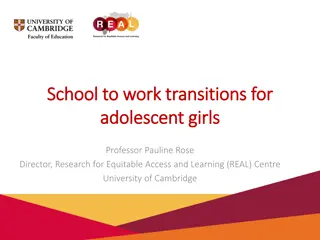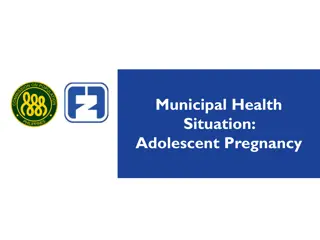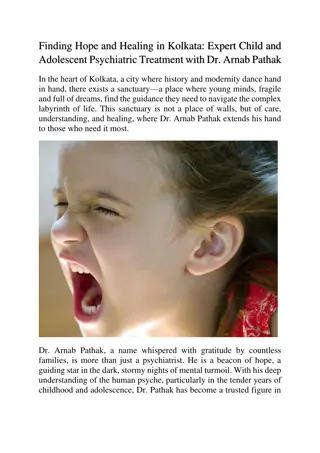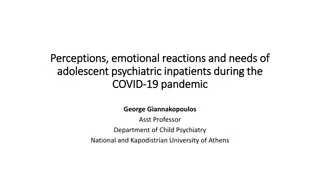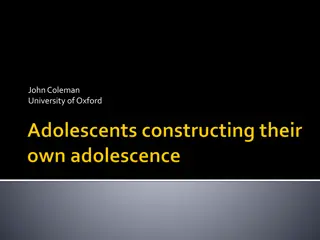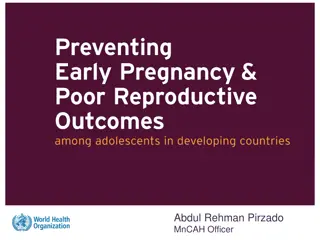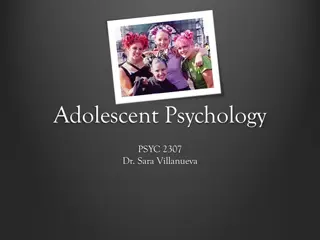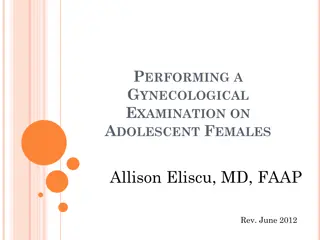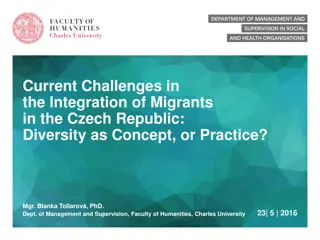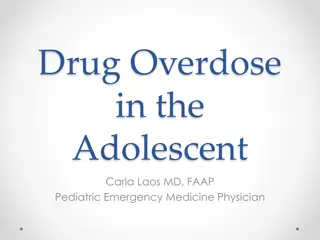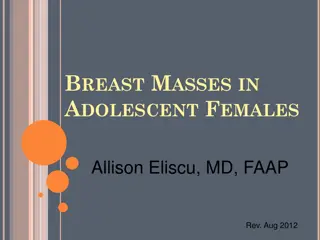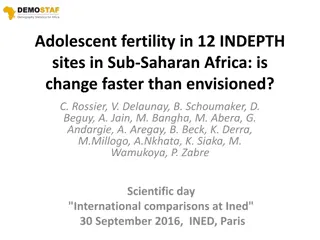The Adolescent Experience: Young Czechs During Social Change
The study explores self-definition and everyday experiences of Czech adolescents over three decades. It compares four cohorts of young Czechs and analyzes psychological differences, focusing on the changing social climate from the 1990s to the early 2000s post-social change in Czech society.
Download Presentation

Please find below an Image/Link to download the presentation.
The content on the website is provided AS IS for your information and personal use only. It may not be sold, licensed, or shared on other websites without obtaining consent from the author.If you encounter any issues during the download, it is possible that the publisher has removed the file from their server.
You are allowed to download the files provided on this website for personal or commercial use, subject to the condition that they are used lawfully. All files are the property of their respective owners.
The content on the website is provided AS IS for your information and personal use only. It may not be sold, licensed, or shared on other websites without obtaining consent from the author.
E N D
Presentation Transcript
The Adolescent Experience: The Adolescent Experience: Young Czechs during Young Czechs during and and after after Social Change Social Change Macek, P., Bou a, O., Je ek, S., ir ek, J., Seryjov Juhov , D., Lomi ov , L. The Institute for Research on Children, Youth and Family Masaryk University Brno, Czech Republic
Aims of study The study reflect the process of self-definition and everyday life experiences in adolescents during last three decades. Self-definition and identity formation in modern and post-modern industrial societies is seen as an important developmental task for adolescents (Erikson, 1968; Kroger, 2003; Harter, 2003). According to the ecological perspective (Bronfenbrenner, 1979), the adolescent self is rooted not only in the microsystems of family, peer arena and school but also in the broader social, cultural, economic and historical context (Baumeister, 1997, Cross & Gore, 2003; Holland, 1997). Our research followed from the idea of a cohort comparison of samples gathered at different historical points (see Silbereisen, 2005). We compare four cohorts of young Czechs. For a better understanding of the psychological differences between them, we provide here a brief overview of typical attributes and changes in the social climate of Czech society during last three decades.
1990- 2000 Time of social moratorium of Czech society In the early 1990s, the Czech Republic was still a post-totalitarian society, which in many respects resembled, metaphorically, the period of adolescence. A social moratorium offered an opportunity for experimentation and the tolerance for breaking social norms was high. Both the young and the older had to undergo the process of re- socialization, experiencing and managing more personal freedom and responsibility than before. Many people had to rearrange their personal values and to choose new life goals and perspectives. Among the post-communist countries, various studies conducted in the Czech Republic have systematically shown a high level of confidence and optimism during the first years of transformation (Macek & Markov , 2004). Adolescents saw new social and life conditions in a very positive way, offering personal opportunities and challenges (Macek et al., 1998). However, society s perceptions and the public mood changed drastically during the second half of the 1990s. The economic crisis had a negative effect on the state budget and the lack of legal framework of privatization led to the restriction of the rights of small shareholders. General dissatisfaction with the political representation grew rapidly. Many Czechs became disappointed and less optimistic about the future than during the previous era (Macek & Markov , 2004; Linek, 2009).
2000 Time of emerging adulthood of Czech society Compared to the 1990s, the first decade of the new millennium can be metaphorically seen as emerging adulthood of the Czech society. The period of social moratorium was terminated, the Czech Republic joined adults in May 2004 when it became a full-fledged member of the European Union (Macek, Bej ek, & Van kov , 2007). The unrealistic optimism and naive trust from the early 1990s was replaced by a more realistic view of society (Linek, 2009). Czech adolescents appears to be more individualistically-oriented than former generations. Relevant empirical findings representing this adolescent cohort from the beginning of new milenium are analogous to results of their peers from Western European countries (Macek, 2003; Nurmi, Liiceanu, & Liberska, 1999). Whereas the post-totalitarian generation of Czech adolescents in the early 1990s perceived social changes in a very positive way, since those changes represented personal opportunities and challenges (getting a good education, the possibility to travel and live abroad, and political and ideological freedom), the millenials are more apt to view the same conditions as ordinary attributes of everyday life. They experience personal freedom, but at the same time must take more responsibility for themselves. The value of education, success, social prestige, emancipation, free time, and entertainment has grown considerably (Macek & Pol kov , 2006). Most young Czechs declare very liberal and tolerant beliefs and values (regarding drugs, abortion, and sexual freedom) and a large majority of them reports no religious beliefs at all. According to data from 2008, only about 18% of them consider themselves religious (Rabu ic & Hamanov , 2009). The dependence on adult authorities has decreased, and, besides the increased emphasis on autonomy and self-regulation, the importance of free and open communication with peers and adults has also increased (Macek, Je ek, & Vazsonyi, 2014).
Current Czech society Time for iGeneration Most of these characteristics can be applied to the current cohort of Czech adolescents who were born in after the year 2000. Besides the effects of specific social change presented above, the comparison of the generations reflects also the macro-structural trends and changes relevant for everyday life experiences of adolescents in the whole of Europe (Mortimer & Larson, 2003; Tomasik & Silbereisen, 2009; see also erek, Macek, Je ek, & Lacinov , 2014). First, the most immediate consequences stem from new informational technologies (mobile phones) and communication virtual networks (Anderson, 2002; mahel, 2008). The extensive use of smartphones with almost continuous communication in online environments, especially social networks greatly affects the lives of current adolescents. J. M. Twenge, a developmental psychologist, writes about the so called age of smartphone and calls the current generation of American adolescents the iGen(eration) . According to her, this is the first generation in which social media and communication via text an image messaging replaced normal(offline) a substantial portion of social contacts and activities. This leads to a situation where they spend less time in person among their peers than the previous generations and spend more time at home with their parents - not actually communicating with parents. In an online social environment they encounter unrealistic expectations, aggression, inadequate etalons of self- evaluation. That may be a reason for experiencing more anxiety, depressive symptoms, or loneliness. According to Twenge (2017) the current generation of teenagers matures more slowly, socially and psychologically. They are very tolerant, but at the same time impatient and hesitant. The second change is related to new demographic trends, above all aging of industrial societies and migration between societies (Fussel, 2002). Third, the contemporary industrial societies are characterized by a high level of diversity, in terms of individualization and plurality of life courses (Elder, 1998), value orientations (Stattin & Kerr, 2001; Tomasik & Silbereisen, 2009) and possibilities. This diversity extends individual developmental pathways for adolescents from a more advantaged social environment, but it can bring restrictions for adolescents from disadvantaged backgrounds (Mortimer & Larson, 2002). The traditional developmental task of adolescence - identity achievement - seems to be changing. Due to online globalization the cultural and social standards, that the adolescents are using, are eroding and becoming more relative (Jensen & Arnett, 2012). Therefore, when studying the effects of social change on adolescents, we have to consider both short-term and long- term effects. Since such study cannot be based only on one-time evaluation, it is useful to conduct a cohort comparison of samples gathered at different historical points (see Crockett & Silbereisen, 2000).
This study: samples and measures Data of four samples are presented. All samples were originally intended to be composed of 50% younger respondents (about 14 years old) and 50% older adolescents (about 16 years old). Sample I was collected in 1992 as a Czech part of Euronet Pilot Study (n = 249, 113 girls, 136 boys). These adolescents represent post-totalitarian generation born during communist regime entering adolescence at the time of the fall of the communist regime. Sample II was collected in 2001 and includes adolescents from the new generation (n = 280, 155 girls, 125 boys). They experienced turbulent period of democratic changes during the 1990s. Sample III was collected in 2011 (n = 362, 171 girls, 191 boys). These respondents represent the generation of adolescents, who have no direct experience with the previous political regime and who have spent all their lives in freedom and democracy Sample IV was collected in 2019 (n = 1 665, 948 girls, 717 boys). They represent the current generation of adolescents. Compared to previous ones, the current cohort IV is much more digital and strongly influenced by social networks. .
This study: sample and measures The majority of measures is based on the Euronet Pilot Study (1992). Measures of daily activities (DA), future expectations (FIS, Nurmi, Liiceanu, & Liberska, 1999), coping strategies (CS), daily hassles in various domains of life (DH) , control beliefs (CB) with respect to school, self and career (L thi, Grob & Flammer, 1989), important representations of self ( Macek & Oseck , 1996), identity styles (Identity Style Inventory, ISI - Berzonsky, 1989), self-esteem and life satisfaction (based on Grob et al., 1991 - WB).
Adolescent self-system and social change The idea of the looking-glass self (Cooley, 1902) describes a process in which a person observes how others view himself or herself, and then incorporates those views into his/her self- perception and self-evaluation. Within this conceptualization, children and adolescents are assumed to internalize the values and opinions expressed by others who are seen as important in their lives (parents, siblings, friends, teachers etc However, people are affected not only by specific significant persons but also by imaginary persons, by social groups, social standards and rules.
Self-Representations Importance Inventory SRII (Macek & Oseck , 1996) is based on a paired comparison of the importance of nine perceived selves: the actual, real self (statement: How I am ); the ideal self ( How I would like to be ); the unwanted self ( How I would not like to be ); the self according to parents ( How I think that my parents see me ); the self according to friends ( How I think that my friends see me ); the self according to adult authorities ( How I think that my favorite teacher, leader, etc., sees me ); the ideal according to parents ( How I think that my parents would like to see me ); the ideal according to friends ( How I think that my friends would like to see me ); the ideal according to adult authorities ( How I think that my favorite teacher, leader, etc. would like to see me ). These nine self-representations are presented in the form of a list of 36 possible paired combinations. The respondent has to decide which self-representation he/she prefers in each pair by considering the questions.
Comparison of the 9 selves across the 4 cohorts 1992 Mean 2001 Mean 2011 Mean 2019 Mean Total Mean F p 0.02 5,32 4.69a,b,c 5.33a 5.14b 5.44c 13.71 <.001 Actual Self 5,19 4.52a,b 4.80c 5.01a 5.40b,c 28.16 <.001 0.03 Ideal Self 4,65 4.30a,b 4.83a 4.69b 3.62 .013 0.00 4.67 Unwanted Self 5,17 5.79a,b,c 5.27a 5.01b 5.10c 14.68 <.001 0.02 Parent Self 4,39 0.48 .693 0.00 4.29 4.46 4.44 4.39 Friend Self 2,36 3.06a,b,c 2.46a 2.52b 2.21c 22.61 <.001 0.03 Authority Self 3,93 4.35a,b 3.73a 3.86b 8.67 <.001 0.01 4.14 Parent Ideal 2,78 2.74a 3.12a,b 2.69b 6.92 <.001 0.01 2.96 Friend Ideal 1,30 1.90a,d 1.52b,d 1.73c 1.09a,b,c 35.69 <.001 0.04 Authority Ideal Post hoc tests were conducted using the Gabriel s pairwise test procedure.
Generation differences in importance of self Generation differences in importance of self- -representations 7.00 representations 6.00 5.00 4.00 3.00 2.00 1.00 0.00 2011 2001 1992 1992 2001 2019 1992 2001 2011 2019 1992 2001 2011 2019 1992 2001 2011 2019 1992 2011 2019 1992 2001 2011 2019 1992 2001 2011 2019 1992 2001 2011 2019 2001 2011 2019 ActualSelf IdealSelf UnwantedSelf ParentSelf FriendSelf AuthorSelf ParentID FriendID AuthorID
Generation differences in importance of self Generation differences in importance of self- -representations representations 7.00 6.00 5.00 4.00 3.00 2.00 1.00 0.00 2011 2001 1992 1992 2001 2019 1992 2001 2011 2019 1992 2001 2011 2019 1992 2001 2011 2019 1992 2011 2019 1992 2001 2011 2019 1992 2001 2011 2019 1992 2001 2011 2019 2001 2011 2019 ActualSelf IdealSelf UnwantedSelf ParentSelf FriendSelf AuthorSelf ParentID FriendID AuthorID Autonomous Selves
Generation differences in importance of self Generation differences in importance of self- -representations representations 7.00 6.00 5.00 4.00 3.00 2.00 1.00 0.00 2001 1992 2019 1992 2011 2019 1992 2001 2011 2019 1992 2001 2011 2019 1992 2001 2011 2019 2001 2011 2019 1992 2001 2011 2019 1992 2001 2011 2019 1992 2001 2011 1992 2001 2011 2019 ActualSelf IdealSelf UnwantedSelf ParentSelf FriendSelf AuthorSelf ParentID FriendID AuthorID Interpersonal Selves
Generation differences in importance of self Generation differences in importance of self- -representations representations 7.00 6.00 5.00 4.00 3.00 2.00 1.00 0.00 2001 1992 2001 2011 2019 1992 2001 2011 2019 1992 2001 2011 2019 1992 2001 2011 2019 1992 2001 2011 2019 1992 2001 2011 2019 1992 2011 2019 1992 2001 2011 2019 1992 2001 2011 2019 ActualSelf IdealSelf UnwantedSelf ParentSelf FriendSelf AuthorSelf ParentID Normative Selves FriendID AuthorID
In sum: Czech adolescents report the highest importance the actual self, the ideal self, and the self according to parents. Also, the unwanted self, self according to friends, and ideal according to parents are more important (compared to others). The importance of self-representations in the contemporary generations of Czech adolescents differs from that of the post-totalitarian generation of the early 1990s. As we assumed, the influence and importance of adult authorities (parents, teachers, etc.) on self-definition has decreased. Moreover, the ideal selves according to others have diminished in importance, too. In contrast to the earlier generation, the actual self and ideal self appears to be more important. Generally, system of self-representations of contemporary adolescents is less normative and more autonomous. High importance of the self according to parents is decreasing, the importance of the self according to friends seems to be stable.
Self-esteem The concept of self-esteem represents a more generalized level of self- feeling and global self-evaluation, with a focus turning to one s overall worth or value as a person (Crocker & Park, 2003). Although the current level of adolescent self-esteem is usually affected by many factors on a personal or a psycho-social level (e.g., personal traits, biological changes and physical maturation, schooling, relationships with peers and friends, relationships with parents and in family (see Dusek & McIntyre, 2003; Harter, 2003), cultural differences based on the dimension of individual collectivist society are also identified (Farrugia, Chen, Greenberger, Dimitrieva, & Macek, 2004; Schmitt & Allik, 2005). These findings are consistent with our assumption that the contemporary or new generations of Czech adolescents will show higher level of self- esteem than the former post-totalitarian .
Self-esteem Std. Error .040 .039 .037 .038 .034 .033 .018 .020 Year 1992 Mean 2.730 2.983 2.788 3.048 2.761 3.021 2.655 2.915 girls boys girls boys girls boys girls boys 2001 2011 2019
Self-esteem - comparison of four cohorts 3.000 2.500 2.000 1.500 1.000 girls boys girls boys girls boys girls boys 1992 2001 2011 2019 The results showed that there was a statistically significant main effect for generation (F(3,2 432) = 5.609; p = .001; = .007), for sex (F(1, 2 423) = 53.526; p = .000, = .007) but not for the interaction of sex with generation (F(3,423) = 1.762; p = .152; = .002). Age as a covariate was not significant for self-esteem (F(1, 24301) = 0.296; p = .585; = .000). 1992 = 2019 < 2001 = 2011
Self Self- -esteem esteem - - comparison comparison of of four four cohorts cohorts Summary As results reveal, contemporary adolescents reported a lower level of self-esteem than previous two generations (2011, 2001). Contemporary adolescents do not differ from post-totalitarians (1992). This result is more evident for girls than for boys. Our assumption that the contemporary new generation of Czech adolescents will show higher levels of self-esteem than the former post-totalitarian is not supported by the data.
Future expectations We assumed that an analysis of future interests of adolescents growing up in different social and political conditions would provide a possibility to examine the role of social changes in adolescent self-development. Earlier research involving a cross-national comparison of eleven Western (long- term democratic) and Eastern (post-communist) European countries showed a clear distinction between the importance of future interest in these two groups (Nurmi, Liiceanu, & Liberska, 1999); therefore similar differences can be expected between our two generations of Czech youth. More concretely, adolescents representing the new generation should have clearer ideas about their future, which points to a higher level of general commitment. They should also be more focused on their own future career, success, and leisure time activities (more individualistic orientation). On the other hand, adolescents representing the former post-totalitarian generation prefered a future family life more and display a higher interest in other people than contemporary generation.
Future expectations Future Interest Scale (FIS, Nurmi, Liiceanu, & Liberska, 1999) consists 14 items. The instructions were as follows: "When you think about the future, what do you consider to be important? Five dimensions were constructed: - the importance of career (two items were included: Getting a good education , Acquiring a good job ), - the importance of being successful (three items: Earning a lot of money , Becoming famous , Becoming important professionally ), - the importance of family (two items: Getting married/living permanently with a partner , Having children ), - the importance of social responsibility (two items: Taking responsibility for parents , Being useful to my country ), - the importance of personal pleasure (three items: Having a good time with my friends , Being liked by other people , Enjoying my vacations and leisure time ).
Importance of future goals/expectations 1992 2001 2011 2019 4.0 3.5 3.0 2.5 2.0 1.5 1.0 Commitment Career Success Family Social Responsibility/Value Social Pleasure Effects of Generation: Commitment: F(3, 2274)= 11.60; p = .000; = .015 Career: F(3, 2535)= 11.11; p = .000; = .013 Success: F (3,2506) = 22.44; p = .000; = .026 Family: F (3,2496) = 10.71; p = .000; = .013 Social Responsibility: F (3,2483) = 13.47; p = .000; = .016 Social Pleasure: F (3,2537)= 15.09; p = .000; = .018
Importance of future goals/expectations 1992 2001 2011 2019 4.0000 3.5000 3.0000 2.5000 2.0000 1.5000 1.0000 Commitment Career Success Family Social Responsibility/Value Social Pleasure Post hoc tests were conducted using the Gabriel s pairwise test procedure: Commitment: 1992 < 2001 = 2011 = 2019 Carrer: 1992 = 2019 < 2001 = 2011 Success: 1992 = 2019 < 2001 = 2011 Family: 1992 = 2001 > 2011 = 2019 Social responsibility: 1992 = 2019 > 2001 = 2011 Social Pleasure: 1992 < 2001 = 2011 = 2019
Coping strategies The Coping Reactions inventory consists of 17 items comprising elements from a variety of different instruments from previous research in this field (Folkman et al., 1986; Haan, 1993). The subjects had to indicate how typical a certain reaction was for them when they were faced with difficulties in life. These reactions were grouped into two categories rational, problem-oriented coping reactions (e.g. "I analyze the situation and try to solve/overcome the difficulty ) emotinal coping (e.g. reactions ("I cry," "I get angry and/or shout," "I am sad and wait until my feelings become better ) social support (help from parents, friends) copping based on making effort (I try it again and again) The subjects answered the items on a 4-point Likert scale ranging from 1 (not at all typical for me) to 4 (very typical for me).
Coping strategies Emotional Rational Social Effort girls boys girls boys girls boys girls boys 1992 2,16 1,78 2,82 2,73 2,18 1,95 3,02 3,03 2001 2,18 1,74 2,86 2,72 2,38 2,00 3,04 2,86 2011 2,36 1,80 2,72 2,73 2,44 2,08 2,87 2,76 2019 2,55 2,01 2,73 2,76 2,29 2,16 2,97 2,88
Coping strategies 3.50 1992 2011 2001 2019 3.00 2.50 2.00 1.50 1.00 0.50 0.00 girls boys girls boys girls boys girls boys Emotional Rational Social Effort Effect of Cohort is significant for both, girls and boys for all strategies. One exception is a rational stratgy for boys.
Generally & with speculation Current cohort of Czech adolescents: they are more autonomous in terms of self-perception and self-regulation than previous cohorts; they are less accepting formal authorities; their parents stay for the the most important persons, however peers (friends)have stable position (for their self-evaluation), (surprisingly?) they are less self-confident compared to previous cohort, more dependent on social approval? (influence of social networks) If they have problems in everyday life, they are more impatient, and less active.
Questions for discussion Based on peresented results, do you expect some differences between Czech adolescents and adolescents from your country? What do you see as the most important indicators of subjective well- being of contemporary adolescents?




